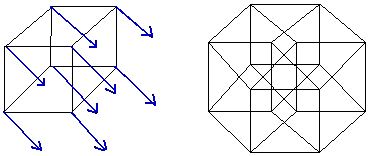3D Cube:

V_3 = a*a*a = a^3 (a 3D cube has 3 dimensions)
P_3 = 6*a*a = 6*a^2 (6 faces, each with a 2D surface of a^2)
d_3 = sqrt((a*sqrt(2))^2+a^2) = a*sqrt(3) (Pythagorean theorem)
4D Cube (Tesseract):

V_4 = a*a*a*a = a^4 (a 4D cube would have 4 "sides")
P_4 = 24*a^2 = 4*P_3 (count faces of a cube made from 8 cubes)
d_4 = sqrt((a*sqrt(3))^2+a^2) = 2*a (Pythagorean theorem again)
This means that a N-dimensional "cube" (the object should have its own name for each dimension) would have a diagonal: a*sqrt(N). And here is a proof that I'm not wrong.
No comments:
Post a Comment